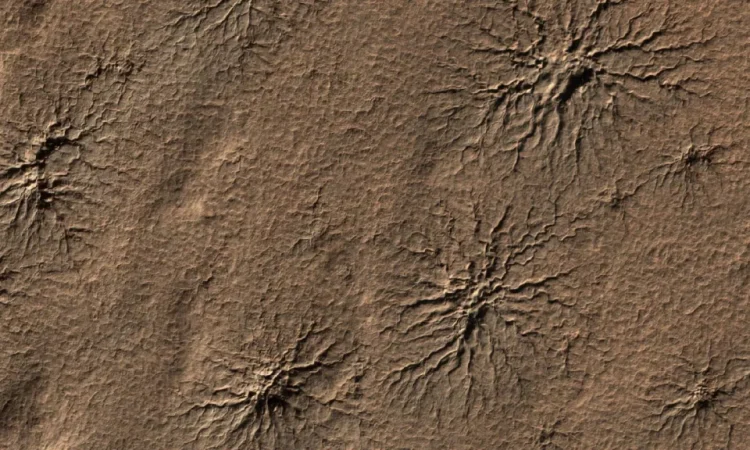
What exactly are “spiders” and how do they form?
In 2003, the Mars Express probe made a fascinating discovery on Mars: strange geological formations, dubbed “Martian spiders,” that have intrigued scientists for years. Subsequently, the ExoMars Trace Gas orbiter captured detailed images of these phenomena, highlighting their singularity. But what exactly are “spiders” and how do they form?
Advertisement
“Spiders” are formations that appear on Mars during the Martian spring. They form when the lower layers of frozen carbon dioxide, accumulated during the winter, sublimate due to solar radiation. This sublimation process leads to the release of gas which, mixed with dark dust, passes through cracks in the polar ice, reaching the surface and erupting like small geysers. The dark powder is then scattered on the ground, creating thread-like spots that extend for up to a kilometer, bringing to mind the shape of a spider. This phenomenon makes the surface of Mars particularly wrinkled and irregular, earning it the name “arachniform terrain”.
What are spiders on Mars
Although scientists had already hypothesized the mechanism of formation of these curious structures, the process remained partly shrouded in mystery. Given the similar conditions, the only way to fully understand the phenomenon was to recreate those conditions in the laboratory.
A recent experiment, published in the Planetary Science Journal, attempted to do just that: replicate Martian conditions in a simulated environment. Using a Jet Propulsion Laboratory (JPL) instrument called “Dustie” (Dirty Under-vacuum Simulation Testbed for Icy Environments), a group of scientists simulated Mars’ polar temperatures (-185 degrees Celsius) and low atmospheric pressure.
NASA’s Mars “spiders” experiment
Inside Dustie, similar potting soil was placed, cooled, and then exposed to carbon dioxide. After about 3-5 hours, the CO₂ has condensed, forming a layer of ice. When the soil was subsequently heated, the scientists observed, with great satisfaction, the emission of a weak jet of gas from the ground, confirming the hypothesis that the sublimation of the ice generates these “eruptions” of gas.
This jet of gas lasted for about 10 minutes, after which the decrease in pressure stopped the phenomenon. The experiment also revealed the formation of ice not only on top of the soil, but also inside it, an aspect not foreseen by the original model proposed by scientist Hugh Kieffer, who had first hypothesized the role of the sublimation of carbon dioxide frozen.
What awaits us in the future
The presence of ice inside the soil could explain the variety of shapes observed in the “spiders” of Mars. The different grain size of the Martian soil could generate jets of different intensity, creating irregular and unique spots on the surface.
“It’s one of those details that shows how nature is a little messier than you expect from a textbook,” commented Serina Diniega, co-author of the study.
Although this experiment provided important new information, the study is not yet finished. To fully understand the process, it will be necessary to repeat the experiment with heat applied from above, as if coming from the Sun, rather than from below, as has been done so far. Only in this way will we be able to obtain a more faithful representation of what really happens on Mars.
Read more

